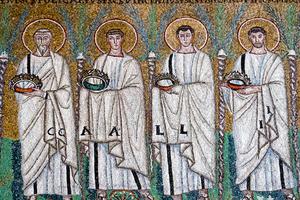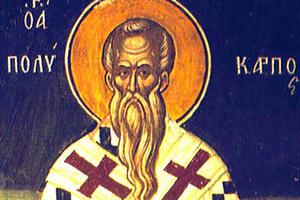St. Polycarp, Bishop and Martyr, Pray For Us
SAINTS & ART: While St. Polycarp “shared the cup of Christ” with his martyrdom, it’s not the only reason we remember him almost 2,000 years later.

St. Polycarp was a bishop and martyr who lived in the first and second centuries of the Christian era. His time is often called the “sub-apostolic age,” because his was the first generation of Christians to take responsibility for the Church after the death of the last Apostle, John. The traditional dates for his life were AD 69-155.
Tradition says Polycarp was converted to Christianity by St. John the Apostle. Polycarp was bishop of Smyrna, an important city in Asia Minor (today’s Turkey), for decades.
Why does the Church remember him? The most important, but not only reason, is his martyrdom. Polycarp was burned at the stake because he would not offer incense to the emperor, an acknowledgement of his deity. (Incense is a symbol of divinity, which is why it’s among the gifts the Magi presented to the Christ Child.) It was said his body would not burn, so he was also stabbed through the heart.
The testimonies we have of Polycarp’s martyrdom affirm that he was a very old man for his times — in his mid-80s — when he died. That’s why I am unimpressed by the fresco supposedly of St. Polycarp in Rome’s San Stefano Basilica by 18th-century artist Marcello Leopardi.
If the caption is not wrong in attributing this fresco to Polycarp, then Leopardi’s Polycarp is no octogenarian.
Polycarp is said to have said he served God for eight and a half decades, and was not about to recant now. The threat of being burned alive was not to be compared, he said, to being in everlasting fire for apostasy. He was martyred along with 12 others. His bones were later taken away and buried.
While Polycarp’s martyrdom earned him the opportunity, as he put it, to “share the cup of Christ,” it’s not the only reason we remember him almost 2,000 years later.
Polycarp’s “Epistle to the Philippians” has survived. That letter, which references similar correspondence by St. Ignatius of Antioch, is among the earliest extant Christian literature from right after the close of the New Testament. As such, it provides valuable corroboration of the authenticity of the faith in the earliest days of the Church — which is why those two saints, along with St. Clement of Rome, are called “Apostolic Fathers.” This is the earliest stratum of what we would later call “Patristic Literature.”
Polycarp fought the heresies of his day, Marcionism and Valentinianism.
Marcionism essentially threw out the Old Testament by claiming that the God who sent Jesus into the world was not the God of the Old Testament. For Marcion, the God of the Old Testament was a demiurge, not necessarily good, who created the material world. One can sense here a certain whiff of the anti-corporeal/anti-material biases of Antiquity. Of course, in order to reach those conclusions, Marcion also heavily edited the New Testament.
Valentinianism was an extremely complicated system that, at root, was based on similar anti-material biases coupled with an extraordinarily complex number of “aeons” and “emanations” by which the universe came to be as is, a kind of gnosticism wrapped up in complicated “spirituality” that perhaps would not seem particularly strange to (though much more sophisticated than) the contemporary “spiritual-but-not-religious.” St. Polycarp was an especially vigorous opponent of Marcionism; his student, St. Irenaeus of Lyons, struck out at Valentinianism.
Another interesting fact about Polycarp leads us back to the ancient controversy about when to celebrate Easter (a not irrelevant question, given that St. Polycarp’s feast this year is about a week away from Lent).
In the ancient world, there were two competing approaches as to when to celebrate Easter. One followed what we do: the first Sunday after the first full moon of spring. The other, which Polycarp followed, hewed to the Jewish Passover. Since the Jewish Passover falls on the 14th day of Nisan in the Hebrew calendar, that is when Polycarp et al. celebrated Easter. That meant, of course, that Easter did not necessarily fall on a Sunday. This practice is called “quartodecimanism.” Eventually, the first pattern prevailed, as Easter is the great Sunday and every Sunday is a “little Easter.” But when Polycarp visited the Pope in Rome, it’s said he celebrated Easter according to his tradition, and the Pope provided him the venue.
Today’s depiction of St. Polycarp is an engraving from John Foxe’s Book of Martyrs. The engraving is rather basic: Polycarp is at its center, facing right (the direction of the righteous), chained to a stake, his hands in prayer. Five onlookers watch as the larger three main protagonists of the execution — a soldier with a spear, an assistant with kindling, another with fire — stoke the fire around the mitered bishop. All these figures appear out of the smoke. Tradition has it that the fire encircled but did not burn him, which was the reason for stabbing him.
While the depiction is relatively basic, it’s worth knowing something about Foxe’s book. It was first published in 1563 and went through four editions in its author’s lifetime, then taken over by others who expanded and embellished it.
The book is a Protestant polemic. Mary, daughter of Henry VIII, reigned as Queen of England from 1553-58. Her six year reign was dominated by an effort to restore England to the Catholic faith and reverse the Protestantism of Henry and Edward VI. Her efforts eventually failed because of her short reign and the return to Protestantism under Elizabeth I. Mary’ opponents titled her “Bloody Mary” because of the Protestants burned at the stake under her.
Protestantism fancied itself as a “return” to the simplicity and practices of primitive Christianity, which it claimed had been suppressed by Catholicism. That’s why Protestants deemed their movement a “Reformation” — a return by reform to ancient practices — rather than the revolution it truly was. If, however, Protestants saw themselves as recovering Christianity as it was supposedly originally practiced, what better associations could they make than to associate themselves — especially after “Bloody Mary’s” campaign — with the martyrs of the ancient Church, especially those burned at the stake?
I can’t say from which edition (and thus when) Polycarp appears, but he would certainly be a figure Protestants would have been earnest to seize, even if his own life was as a loyal son of the Church in communion with Rome.
- Keywords:
- st. polycarp
- apostolic fathers
- martyrs
- saints & art














